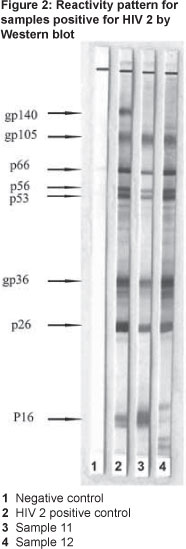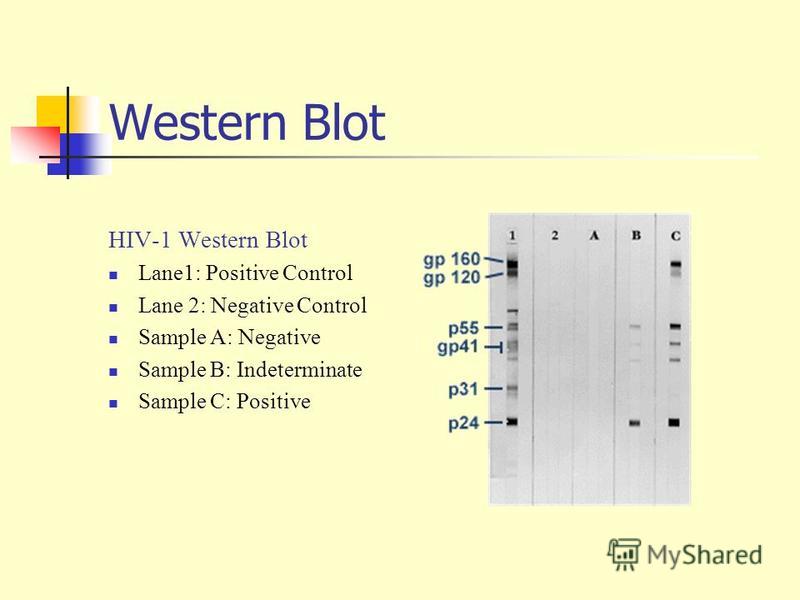
Proteins from known HIV-infected cells are separated. If the IC method allows simultaneous measurement of antigens and antibodies, however, the false-positive rate is 0.2% to 0.4%, which is almost the same as that of the other methods. The confirmatory HIV test employs a western blot to detect anti-HIV antibody in a human serum sample. The false-positive rate (probability of testing positive without HIV infection) of this method was said to be higher than that of the ELISA method. Tests that are called same-day or rapid tests use the IC method.This method is therefore especially useful in patients with suspected acute infection. Since they can be detected before the body develops antibodies, the window period is short. The Western blot method is used to detect antibodies to viral proteins with high specificity, but its drawback is a longer window period (several months in some cases). Confirmation tests use the Western blot or reverse-transcription polymerase chain reaction (RT-PCR) method.It takes the human body an average of 22 days to produce antibodies after infection, and more than 99% of people are antibody-positive 3 months after infection. In recent years, however, methods capable of simultaneously measuring antigens and antibodies have been developed, and the chemiluminescent immunoassay (CLIA) method is commonly used in hospitals. Specimens that do not confirm positive by Multispot may require further analysis by HIV RNA PCR.Screening tests have used the enzyme-linked immunosorbent assay (ELISA) or immunochromatography (IC) method to detect HIV antibodies. Specimens that are reactive by initial HIV-1/HIV-2 antibody immunoassay should be confirmed by Multispot testing. In brief, a WB test consists of a set of nine HIV-specific bands (gp160, gp120, gp41, p66, p55, p51, p31, p24 and p17). This confirmation immunoassay, also known as Multispot, detects seroconversion earlier than Western blot and eliminates most indeterminate results that occur due to nonspecific reactivity from alloantibodies. The follow-up confirmation test for reactive results is a new HIV-1/HIV-2 differentiation immunoassay. The first test in the new algorithm remains the combination HIV-1/HIV-2 antibody immunoassay. HIV 1& 2 WESTERN BLOT is an in vitro qualitative immunoassay for the detection of anti bodies to HIV-1 & HIV-2 in human serum/plasma. Therefore, CDC and Clinical Laboratory Standards Institute (CLSI) have designed a new HIV testing algorithm that eliminates Western blot confirmation. Third generation HIV-antibody immunoassays can detect seroconversion as early as 22 days after infection, while Western blot may not show reactivity until 4 weeks or more. Improvements in sensitivity of newer generation HIV-antibody screens have created the dilemma of falsely-negative Western blot assays. Persons with stable indeterminate patterns lasting 6 months or more, in the absence of known risk factors and clinical symptoms, may be considered negative for HIV-1 antibodies. These immunoassay tests are the preferred screening tests which detect HIV-1 p24 (capsid) antigen and antibodies (IgM and IgG) to HIV-1 and HIV-2. Most seroconversions will be detected in repeat Western blots within 3 months. 4.2.2.1 HIV antigen-antibody laboratory-based tests. These individuals should be further evaluated by HIV RNA PCR testing and follow-up HIV serologic testing. The Western blot test separates the blood proteins and detects the specific proteins (called HIV antibodies) that indicate an HIV infection.

During the test, a small sample of blood is taken and it is used to detect HIV antibodies, not the HIV virus itself. Individuals with a positive Western blot lacking the p31 band should be counseled that, although they may be infected, uncertainty exists about this conclusion. A Western blot test is typically used to confirm a positive HIV diagnosis. The complete medical history must be considered in interpreting indeterminate Western blots. Indeterminate patterns may be either false positives or early seroconverters.

The majority of indeterminate patterns consist of p17, p24, or p55 alone, or combinations of these 3 bands. Presence of any 2 bands p24, gp41, gp120/160

The criteria established by the Centers for Disease Control and the Association of State and Territorial Public Health Laboratory Directors for interpretation of Western blots are as follows: In some cases, reactions with gp120 and gp160 may be due to antibodies binding to multimers of gp41. Anti-p31 also diminishes, but not to the same extent as anti-p24. Antibodies to p24 and p55 decline after the onset of symptoms, while antibodies to envelope glycoproteins persist. The earliest antibodies to appear are directed against gp160, gp120, p24, and p17, followed shortly by antibodies to gp41, p55, p66, and p51. A consistent sequence of antibody responses occurs after infection.


 0 kommentar(er)
0 kommentar(er)
